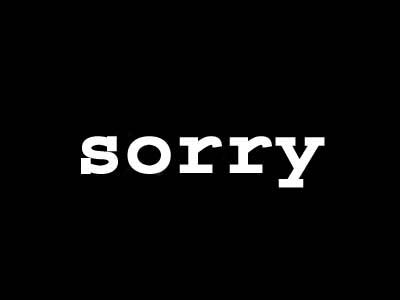
In the rapidly shifting era of blogger and media relations, we can expect one thing to occur as we forge ahead, mistakes. It happens to the best and the worst of us.
This isn’t a generic post on how not to make mistakes, or if you do, how to apologize, per se. This is an example of true transparency and public soul searching that will hopefully help and inspire PR practitioners, journalists, and bloggers to learn from the mistakes of others – and hopefully work together when unintentional or harmless mistakes are made.
Let’s talk about transparency for a moment. You hear that word a lot across the socialmediasphere – almost to the point where it may be losing its original value and intent.
Transparency = sharing the bad things as well as the good.
Here’s an example of transparency in action:
I blog passionately and incessantly about how to work with media and bloggers in ways that foster relationships and humanize the process of storytelling. I also run a public relations agency. It cuts deep when one of your own makes a mistake.
Yes, I’m one of the louder voices on media and blogger relations, so there’s a sense of irony here when someone who works with me is the subject of this post. For this to be verbally called out to me, as if I already didn’t make the connection on my own, well, it hurts. But, it’s fair and I’ll take it on the chin.
Nowadays, any mistake made in PR is really an occupational hazard where one wrong move can cause a domino effect that has the potential to eradicate months or even years of hard work.
In (their) defense, this person did not blast a generic media list generated through a PR database, nor did this person send information to someone who doesn’t cover or write about products in the space. This predicament is representative of something many of us haven’t really discussed, but it’s worth exploring – as this is likely to occur industry-wide.
So here’s the question:
Is any form of unsolicited email considered spam even if you’re sharing relevant information to one person or a group of people? Or, would you consider the sharing of related content more along the lines of “Bacn,” and if so, would you react differently knowing that the person reaching out to you at least went through an initial exercise of connecting the dots?

Let’s take a quick look at the differences of each:
Spam is intrusive, shotgun-style blasting that usually favors quantity versus quality – meaning, that it doesn’t take into account your interests or preferences.
Bacn (introduced to me by Chris Brogan) stems from the idea that it is better than spam, but not as good as a personal e-mail. Bacn differs from spam in that the emails are not unsolicited: the recipient has somehow signed up to receive it. Bacn is also not necessarily sent in bulk – Wikipedia.
Tofu (new category – suggested name) is email that is sent individually to people who are pre-qualified or identified as being related to, or interested in, a particular category or topic. Or, they have made their email publicly available on their site, thus intentionally or inadvertently inviting contact. I’m not sure what to call it, but the idea for tofu was inspired by the fact that we can almost make it taste like something else, but at the end of the day, it’s still not the real thing.
The difference between Bacn and Tofu is that these emails are somewhat personalized and related to a particular event or milestone, but are usually unsolicited and sent to multiple people as an update, a request for meeting, or seek other forms of response. It isn’t categorized as spam because it is not an automated process and the lists of people (recipients) are hand-built and individually sent.

There’s a fine line between outreach being categorized as “not unsolicited” and getting aligned with a particular topic (pitch) based on employment, experience and writing history. In this case, one more step of due diligence would have brought the thin line into focus and prevented this issue altogether. That lesson was immediately learned and heartfelt.
But in this case, and I have to imagine it is not unique, this is email aligned more with the definition of Bacn and Tofu versus Spam. Now, at the end of the day, the devastating response and ensuing fallout clearly indicated that the differences didn’t matter. So in a world where perception is 9/10ths of the law, then “personalized,” yet unsolicited email is still regarded as Spam. Even if thought and research went into the process, it is still unacceptable – as it should be.
What do we learn from this?
If you’re following the recipe to success in blogger and media relations, then you can’t stop short of following the most important steps of doing things the right way. You can still deviate from the original steps in order to add personal flavor, but cutting corners only ruins the experience and the taste with which we’re ultimately left.
Truth is, many, if not most, PR people still spam. I have an inbox full of examples of real PR spam, with only 10%, at best, showing signs of promise, and maybe another 5%, falling into the Tofu category. The honest answer is that if you’re looking at the process of shifting from automated outreach to one-on-one pitching, then the road from here to there may seem endless and improbable. If you start on the path and decide that 1/2 way is sufficient, then you may want to glance ahead and realize that the right way to do things is just ahead of you. That’s where you need to be.
There are real consequences for not truly engaging with people one-on-one with a real sense of purpose.
The differences, and the answers, are discoverable by reading the work of bloggers and reporters before you reach out instead of simply aligning them with particular topics or industries. This is about building relationships and rising above the fray. If you’re not interested in the industry, product, or service you represent, or what the most influential voices have to say about the subject, then do us all a favor and pursue your dreams elsewhere.
This isn’t about collecting a paycheck. We represent companies as if they’re our own. We’re entrusted with the responsibility of carrying that brand forward and protecting its integrity. And, it’s also about your personal brand too. It’s yours
to define. Own it. Shape it. Cultivate it.
I’d like to think that we’re intelligent people, and I truly don’t believe that the only way to learn new things is by burning our hands on a hot stove until we finally figure out that we’re doing it wrong.
We’re all in this together.
When mistakes are made, and no, we’re not perfect, it’s how we address them that define character – on both sides.

Sometimes saying sorry is not enough. However, saying sorry should count for a lot, especially when the intent was genuine. And an apology is the first step in learning a lesson and mending the relationship. We’re only human, and as long as there are real people on both sides of the equation, then an opportunity for understanding, empathy, and advancement should prevail.
As stated earlier, there’s a difference between spam and pre-qualified outreach and it’s all rooted in genuine (albeit partial) intent. Nothing beats homework and real one-on-one conversations that show; 1) You know who you’re talking to and why what you represent matters to them and their readers; 2) You packaged the story specific to their preferences; 3) You are an expert in the field in which you work and you are knowledgeable about the playing field and the players who also define the space; and 4) You disdain the taste of spam, bacn, or tofu – in principle anyway.
I don’t know about you, but I’m always learning and observing each and every day. Today, we learned a lesson the hard way and I’m sharing this experience to help raise the bar industry-wide.
The tolerance for mistakes is razor thin and the attention span of those we wish to reach is even thinner. If the pressure is on you to generate results in bulk, then the onus is on you to also push back and contribute to the resetting of a dying breed of unrealistic expectations and relationship-damaging pressure.
Gone are the days of the boiler room and the blast mentality associated with faceless PR. Now more than ever, relationships count for everything and nothing substitutes for personal experience, wisdom, expertise, and perspective.
The future of PR is personal and conversational. Get used to it.
UPDATES:
All Things Digital runs this post in the “Voices” column.
Stowe Boyd shares his thoughts in, “The Growing Backlash Against PR Spam, And The Rationale For MicroPR.”
Jeremy Toeman adds his voice to the subject, “Hey bloggers, tell us how to pitch you!”
Additional Resources on PR 2.0:
– In Blogger and Media Relations, You Earn the Relationships You Deserve
– Free ebook: The Art and Science of Blogger Relations
– The New Rules for Breaking News
– The New Rules of Breaking News, Beware of Embargoes
– Building Relationships with Bloggers
– Dear Chris Anderson, an Open Letter to Make Things Right
– PR 2.0 = The Evolution of PR, Nothing Less, Nothing More
Connect with me on Twitter, Jaiku, LinkedIn, Pownce, Plaxo, FriendFeed, or Facebook.





Brian I like the first picture of the tree in the hand. It is a true representaion of bloger/media relations, or any relationship for that matter. It is all about cultivation. Making sure it gets water when it is suppossed to but not too much or you will drown it.
Why do PR practitioners say they dislike spam and yet it is still being practiced? Is it a few bad apples, or is it that they are getting some return?
Great post, Brian. I think the biggest issue is that not all bloggers are alike much like traditional media. Some are more accepting of unsolicited pitches than others, and the ones that aren’t are more likely to make an example of folks that try to score a quick mention with an untargeted pitch. All of this begs for practitioners to spend more time researching contacts up front. It might mean more hours building contact lists, but in the end it should bear more fruit.
Wow, I sure have direct experience with this from the “blogger griping at guy sending me” side. I posted what turned out to be one of my most popular posts (and this embarrasses me, because I’m a positive guy) about a guy pitching me fairly generically about a product that was roughly in my space. I was frustrated, probably due to the volume of such blind pitches that I receive, or maybe just due to a rough day.
From looking at your post, and with your perspective, I can see how maybe there’s a need to better understand this kind of relationship and how to get potentially relevant information into useful hands in such a way that all sides feel appropriately respected. (Remember, bloggers aren’t scott free in the “being asses” department.)
I’ll have to think more on this, but I like where you’re going. Tofu. The Tofu robot was a good touch.
I learn something new everyday–Tofu–Bacn, who knew?
Seriously though, I think when you look at the PR end of things–when we pitch editors and the media, their beats are very clear, cut and dry. This makes sending targeted emails easier. We know as PR we are invited to pitch them.
From the Blogger end, there are still plenty of blogs that while they may have a clear niche, don’t have a page that clearly defines what they do and do not want to receive. So you may have something that perfectly aligns with what that blog speaks of and the audience it speaks to and they may clearly have their email published inviting contact, so then is your pitch spam, Tofu or Bacn? That is still a gray area.
And I agree about transparency, I feel like people are just throwing it around like a buzz word now.
Showing thoughtfulness, care, and lack of arrogance is giant.
Any successful blogger quickly learns that “me-ness” doesn’t scale. (Although Brogan’s giving it his best, god bless him.) When relationships are key, what does a blogger do with thousands of emails, each crying out for a little piece of a relationship? And if you’ve got a message you think would resonate with that blogger’s community, how do you make that connection?
None of it is easy or formulaic, and we damned sure don’t have the best practices nailed down. But thinking about it, talking about it, approaching it with intelligence and consideration, makes such a difference.
This is a great post, Brian, I hope it gets a lot of eyes. Whether or not you have imperfect people in your organization (how dare you!), you are an important part of making this particular conversation work better.
Everybody makes mistakes. The most challenging part is not to say sorry when you made one, but to stay calm when you bear the consequences of someone else’s mistake.
Communications appease anger. You Brian surely communicate extensively. I think we are all appeased.
Brian, as someone who eats lots of tofu (always an aspiring vegetarian), and a PR guy who has lived pre-social media and through it to now, you’re offering sage advice. But really, wasn’t good PR all about relationships, anyway? One of my bosses, Don Middleberg, urged staff to take journalists out for lunch and get to know them. Is it any different with bloggers? No. So instead of a lunch meet, you’re having a phone or online conversation, or catching someone in the hallway of a tech meetup. Another point is this: So much time is being spent defining social media PR when most journalists (outside the early adopter SF tech community) writing about billion dollar industries are still operating in a Web 1.0 or Web 0.0 environment. They’ve never read Tech Crunch or Mashable. They’re covering pharma, energy, consumer goods, government, etc. Some of them still want faxed press releases, and that’s all. So it’s an evolution being driven well by this community. Learning process for practitioners? Indeed. I’ve made my own mistakes along the way. But we’re all hopefully improving.
I agree amends should be made. As I was not privy to the scenario, I am sure you did the right thing.
Devil’s Advocate: I also think reporters and bloggers who accept pitches can be absolute tyrannical idiots with this stuff. There’s a two way street, but because we are PR, we will always get t the short end of the stick. Sometimes I weigh the source, too.
First off, Bacn sounds so much more appetizing than Tofu I strongly suggest their order be reversed 🙂
Second, you tease us with this “I’m going to take it on the Chin” but don’t tell us what exactly the SNAFU was? Well…. What was it?
I for one have forsaken the press releases and mass/target email campaigns entirely. It’s less work and so much more effective when people come to you via social media sources.
Brian, I picked this up in your Facebook status update. I never thought of putting a link there. Smart!
I worked in Japan for many years. In speaking Japanese, some version of “I’m sorry” is used continuously in conversation. That is one extreme but I find today that I cannot help but apologize and make amends when appropriate.
About this: Is any form of unsolicited email considered spam even if you’re sharing relevant information to one person or a group of people?
If you think about the way we, as PR practitioners, pitch traditional media, it’s often cold-calling even if you’ve identified those who might be interested in your topic. If you’ve never spoken to or e-mailed someone before then the first time you contact them — that’s a cold call. It doesn’t mean they haven’t been qualified though. It also doesn’t mean that they won’t be interested in your pitch, just because you don’t know them yet. Isn’t that how you build a relationship? Make friends? You start with a first step, first contact, first hello.
As someone who has been both the pitchee and the pitcher, I can say that the difference to me is that, after years of doing this, traditional media know what PR is doing. They expect it. Since not all bloggers have a traditional media (or PR)background, they don’t expect it, know what’s happening, or know how to handle it. And that’s why we keep having this conversation.
Because a huge new group of potential media outlets (bloggers)didn’t get the memo — and PR people, whether they’ve qualified the lead or not — continue to inundate them with unsolicited e-mail.
Maybe someone should warn neophyte bloggers that this is going to happen, and provide a list of tips on how to handle it. First, and foremost, don’t let it ruin your day. You can’t control ants at the picnic — it’s going to happen. So just deal with it.
Maybe some of the traditional media out there have some great tips for bloggers on how to handle it, politely and quickly. I like Shannon Nelson’s idea of encouraging bloggers to include a page about what you do and don’t want to receive. Could that page include a separate e-mail for introductions or pitches?
Another important point — for PR and bloggers — is not to burn bridges. A pitch may seem way off base, but if the source may have relevant info about your topic, then the next pitch may be a home run for you. Unless the PR person is too embarrased or hurt to ever write you again. Then they might go to your competition instead.
I’m sure your readers can provide many more ideas. How ’bout it?
I posted my thoughts here: http://snipr.com/285vd
Short term, whatever PR Agencies can do to gain credibility is a good thing. This means becoming the signal and not part of the noise.
Beyond that, whether it’s spam, bancn, or tofu, the problem resides in that it’s currently all foodstuffs from Phillip Morris, a company that makes crap. PR Agencies need to reinvent themselves into something beyond invisible broadcast-only connectors now that people are making their own connections. They have a VERY important part to play in the new generation of social relations. If a new level of credibility isn’t earned agencies will get increasingly marginalized.
Not buying it. We have both run our own agencies, and know that at the end of the day, it’s our name that’s on the door.
When I had people working for me, I vetted everything to make sure I didn’t get my fingers slammed in the door. Right now, I’m vetting my agency’s lists for the same reason: because I have to answer to the VP and CEO, not the firm.
Someone from your firm was emailing a reporter/blogger to her personal email address. And, possibly, more than once.
That’s the story – someone messed up, but the buck stops with you. Short post, easy post.
Or, as my best friend says: ball up.
Miguel, that first picture is representative of what this is all supposed to be about…planting and cultivating relationships. Indeed it’s a few bad apples and some of us are working on it. In this case, we identified several issues and fixed them. Now, we’re working to help others. It’s important. As you say, all it takes are a few bad apples…
JWebster, Thank you. Yes, you’re right. It’s different for every person, but it’s up to us to not “try” it unnecessarily. Spending more time on this upfront is all it takes, and I support it!
Chris, amen brother. At the end of the day, the onus is on PR to remove the potential for misperception. In this case, I’m also asking the community if they think that “tofu” email deserves the same response as the worst examples of spam. I think we all know that the answer is, “just take the next step and ensure that you’re creating a real relationship,” and perhaps that’s the answer. Maybe it’s black or white. Either way, I stand for building relationships and doing things one-on-one. Less is more.
Shannon, well said. Transparency and authenticity are starting to lose their value and unfortunately have become the latest buzzwords.
Hi Sonia, thank you so much. You’re exactly right!
Xavier, yes, people make mistakes. Acknowledgement and apologies should count for something. However, you earn the relationships, and the reactions, you deserve – especially considering the hostile climate these days.
Neil, it’s great to hear from you! Yes, PR was always supposed to be about relationships, but it really isn’t on a grand scale. It’s about meeting expectations and delivering results. These days, PR is measured by the pound (in large part) and many professionals – outside of my agency – believe that blasting is still an effective mechanism for achieving these goals. The moral of the story is that we have to focus on relationships and not numbers. It’s our job to help level expectations, otherwise we indirectly contribute to the system that is unraveling “relations” from public relations. Great thoughts Neil!
Geoff, rock on man.
Csuspect, lol! I took it on the chin by saying that if any one of my teammates are out there doing things wrong, then it’s on me. So this post is dedicated to 1) painting an accurate and leveling portrait of the landscape and 2) teaching PR people how to do it the right way. 🙂
Thanks Linda! I believe sorry isn’t said enough over here. What do you think?
Janie, qualified cold-calls in traditional media is part of the tofu umbrella in new media. You’re right, and that’s part of what I’m talking about. Sometimes, the conversation has to start somewhere! I love the memo analogy!
Sam, brilliant!
Jeremy, the spirit of the post says exactly what you’re saying. However, not everyone here is as experienced as you, so the longer version of the story helps people understand why this is wrong and how to do things the right way – whether they work with me or not. Thanks for keeping it real…time to ball up!
I sent a message to several hundred new subscribers to one of my feeds, one-at-a-time over a few days.
Although over 80% of responders classified it as a desired message that they would be glad to receive more of, I would say, based on all responses I received, the message I sent was somewhere between “Bacn” and “Tofu” on the Spam scale.
However, though an additional 9.75% of responses were neutral, the few negative responses were very negative, and also clearly snap judgments (because who’s going to read something when they already believe it to be spam?)
It made me consider that even though over 90% of responses were non-negative, I wouldn’t send out a similar message in the future.
it is your motivation that determines my reaction
psychically i know what your intentions are, and if they are to give me something, i may exchange my attention for your message
but if i intuit that you are only interested in yourself, and want to get something from me, eff you, and if i meet you at a party, i may pick a fight
in short, i hate ads, pr is nearly as gross. i would say do something useful in the world, but i know you are not capable of it
definitely an old-paradigm profession
From one entrepreneur to others, this sort of bruhah would make me think twice about hiring a firm at all. I don’t know of too many PR firms that will monitor your industry news and ferret out the best reporters, at least not for anything less than $10K/mo, which was a non-started in my bootstrapped cash-starved startup. And even then, I’m not sure they’d know a relevant story when they saw it. Most entrepreneurs would be well-served by monitoring news and building their own list of media contacts. If you want to hand off your list to a freelancer or firm, or have your marketing manager do your outreach, you’re in a lot better position than by expecting an agency to build the perfectly researched media list for you.
Brian, I think a mea culpa is the right way to go. I’ve had this happen to me with members of my agency.
The bottom line is that many PR people have a lot to learn with blogger relations. I look at it this way: it took until now for professionals to figure out how to properly pitch traditional journals, so that means that the folks who understand blogger relations are light years ahead! I think our PR instincts tell us the right thing to do, it’s just many don’t know how to put it into action. Thanks for sharing what happened and enlightening us on how to handle this type of situation.
Thanks for the insightful post Brian. As I navigate my way through forming realtionships with Bloggers, your post provides helpful info.
Transparency is only good if the walls are transparent, not what is behind the walls. The builders of the walls should not be invisible either.
I have no doubt of your sincere intent in writing this but as a visitor to your blog, the context of this apology is shrouded in mystery. I hear you saying you’re sorry but sorry for what?
You talk about spam, bacn and tofu. I understand those distinctions. But are you saying that you sent spam, bacn or tofu or one of your clients and someone complained in a blog? I’m completely inferring this because this entry lacks any specificity. I can see why you wouldn’t want to name names but it means that anyone who doesn’t know you or your working situation is a little lost.
A vague apology isn’t really an apology at all. One has to state what actions one has hurt which people, acknowledge this injury and promise a remedy or at least empathize. You acknowledge that someone (who?) has been injured in some way (how?) and you are sorry (empathized) but without acknowledging what exactly occurred, one isn’t transparent and it looks like a person is placating someone who is angry.
I think you mean to do more than say “I’m sorry, I was wrong, I’ll try not to do it again” but without saying what “it” is and who was wronged, it seems like a process that is opaque and obscured which is the opposite of transparent.
But it is a start.